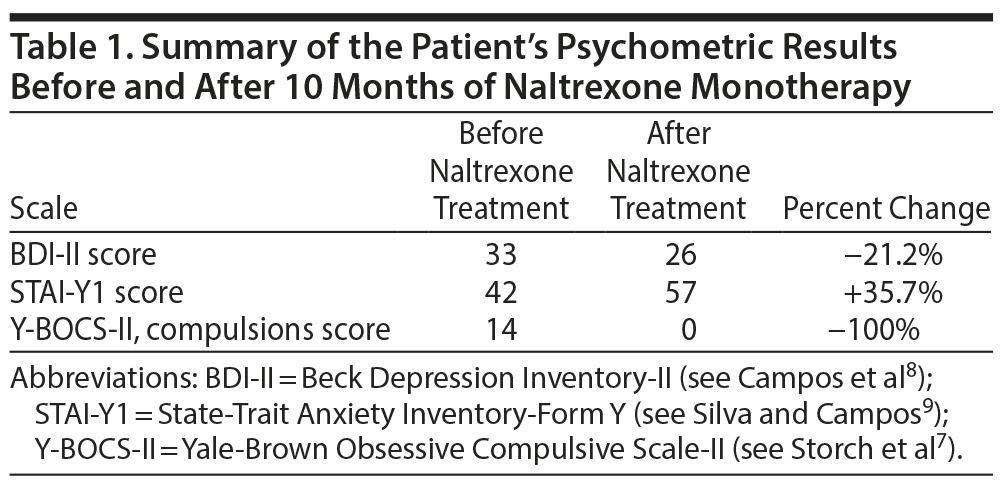Because this piece does not have an abstract, we have provided for your benefit the first 3 sentences of the full text.
To the Editor: Compulsive sexual behaviors are excessive or uncontrolled sexual cognitions or behaviors that lead to clinically significant distress with undesired medical, social, occupational, legal, or financial consequences. Typically, compulsive sexual behaviors are characterized by the failure to resist the urge for a given sexual behavior, which is frequently followed by feelings of guilt, regret, and self-reproach, leading to their inclusion in the spectrum of impulse control disorders. The treatment of compulsive sexual behaviors is challenging, with reports of varying success for several psychotherapeutic and pharmacologic interventions, including serotonin reuptake inhibitors, mood stabilizers, and antipsychotics.
Compulsive Sexual Behaviors Treated With Naltrexone Monotherapy
To the editor: Compulsive sexual behaviors are excessive or uncontrolled sexual cognitions or behaviors that lead to clinically significant distress with undesired medical, social, occupational, legal, or financial consequences.1 Typically, compulsive sexual behaviors are characterized by the failure to resist the urge for a given sexual behavior, which is frequently followed by feelings of guilt, regret, and self-reproach, leading to their inclusion in the spectrum of impulse control disorders.2 The treatment of compulsive sexual behaviors is challenging, with reports3 of varying success for several psychotherapeutic and pharmacologic interventions, including serotonin reuptake inhibitors, mood stabilizers, and antipsychotics. Evidence4,5 suggests that naltrexone, an opioid antagonist classically used in the treatment of opioid dependence, could be an option for treatment of these conditions. The effects of naltrexone have been proposed to result from blockage of opioid receptors on γ-aminobutyric acid interneurons in the ventral tegmental area (VTA), thus inhibiting VTA dopaminergic neurons that are thought to underlie the reinforcing properties of the compulsive behaviors.6 We report the case of a patient with compulsive sexual behaviors who was successfully treated with naltrexone monotherapy.
Case report. A 27-year-old man first presented to our outpatient psychiatry clinic for self-reported "sexual compulsions." The patient indicated spending a significant amount of time and money fantasizing about and hiring prostitution services, describing a particular fixation with "transvestite men." He considered himself heterosexual and described these sexual behaviors as "strange perversions," causing shame and disgust that he felt unable to control. The patient was referred for psychological assessment and completed the compulsion subscale of the Yale-Brown Obsessive Compulsive Scale-II7 to assess the nature and severity of his sexual compulsions (Table 1). While the most distressing compulsion was intercourse with transvestite men, occurring at least once every 2 months, he also reported excessive viewing of pornography no less than 3 hours and up to 10 hours every day. Although a common compulsive sexual behavior, he did not report compulsive masturbation. The patient felt unable to control these behaviors and reported clinically significant depression and anxiety symptoms. He was taking fluoxetine 20 mg/d and attending a supportive psychotherapy program, but he reported no long-term benefit from these and prior treatments, including multiple antidepressants, mood stabilizers, neuroleptics, and other courses of psychotherapy. Irrespective of treatment optimization (fluoxetine 40 mg/d and aripiprazole 10 mg/d), symptoms were unchanged, and a trial of naltrexone (50 mg/d) was proposed.
After 2 months, the patient reported significant improvements in the reduction of sexual fantasies and control of sexual impulses. He had not engaged in intercourse with prostitutes, and he was very satisfied with his treatment. Since he attributed no benefit to the use of other medications, he had stopped taking them by his own initiative and had only been taking naltrexone for several weeks. He continued to attend psychotherapy. The naltrexone dose was increased to 100 mg/d. After 10 months of naltrexone monotherapy, sustained improvements were noted, and the patient reported one recurrence in use of prostitution services. He described a spontaneous attempt to stop naltrexone, but he resumed medication after only 2 days due to increased thoughts and urges related to sexual acts. A follow-up psychological assessment (Table 1) showed improvement in his depressive symptoms but an increase in anxiety. While the patient continued using pornography no more than 3 hours per day, he did not consider this behavior as problematic.
There are other publications4,6,10-12 reporting efficacy for naltrexone in cases of compulsive sexual behaviors. Raymond et al4 reported 2 cases of improvement in sexual compulsions and psychosocial functioning with use of naltrexone to augment therapy with fluoxetine. Bostwick and Bucci6 found similar results in a case of internet addiction with occasional sexual compulsive behavior in which the patient’s sexual compulsions remitted after naltrexone was added to treatment with sertraline. Ryback11 described an open-label study of naltrexone in 21 male adolescent sex offenders concomitantly treated with stimulants, antidepressants, mood stabilizers, antipsychotics, or other medications. Of those patients, 71% reported a significant reduction in sexual arousal, masturbation frequency, and sexual fantasies with naltrexone. In 9 of 10 patients, compulsive sexual behaviors reverted to baseline levels when naltrexone was administratively discontinued.11 Grant and Kim10 reported remission of stealing and sexual urges in a case of kleptomania with comorbid compulsive sexual behavior after treatment with high-dose naltrexone (150 mg/d), but it is unclear if the opioid antagonist was adjunctive to high-dose fluoxetine or used in monotherapy. The case described here adds to this literature since sexual compulsions were successfully treated using naltrexone monotherapy, which is consistent with the description by Kraus et al12 of reduction in excessive internet pornography viewing after treatment with naltrexone monotherapy.
There is also evidence to support the use of naltrexone in the context of other disorders of the impulsive-compulsive spectrum, namely compulsive buying,13 kleptomania,10 pathological gambling,5 alcoholism,14 trichotillomania,15 eating disorders,16 and self-injury behaviors in borderline personality disorder.17 In most cases, naltrexone is used to augment other treatments, such as antidepressants, but there is evidence, for example in alcoholism, that naltrexone monotherapy is equally effective as combination treatment, while reducing the likelihood of side effects or drug interactions.14 Furthermore, naltrexone does not appear to interfere with sexual function and has even been proposed as treatment for erectile dysfunction.18 However, there could also be advantages for combination treatment. Here, we found an increase of anxiety symptoms, which could be attributed to the interruption of treatment with fluoxetine or to a direct effect of naltrexone, as has been suggested in other studies.19 In conclusion, while naltrexone monotherapy could be a well-tolerated, safe, and effective medication for sexual compulsions, randomized and controlled trials are necessary to confirm effectiveness and safety.
References
1. Black DW, Kehrberg LLD, Flumerfelt DL, et al. Characteristics of 36 subjects reporting compulsive sexual behavior. Am J Psychiatry. 1997;154(2):243-249. PubMed CrossRef
2. Kafka MP. Hypersexual disorder: a proposed diagnosis for DSM-V. Arch Sex Behav. 2010;39(2):377-400. PubMed CrossRef
3. Dell’ Osso B, Altamura AC, Allen A, et al. Epidemiologic and clinical updates on impulse control disorders: a critical review. Eur Arch Psychiatry Clin Neurosci. 2006;256(8):464-475. PubMed CrossRef
4. Raymond NC, Grant JE, Kim SW, et al. Treatment of compulsive sexual behavior with naltrexone and serotonin reuptake inhibitors: two case studies. Int Clin Psychopharmacol. 2002;17(4):201-205. PubMed CrossRef
5. Kim SW, Grant JE, Adson DE, et al. Double-blind naltrexone and placebo comparison study in the treatment of pathological gambling. Biol Psychiatry. 2001;49(11):914-921. PubMed CrossRef
6. Bostwick JM, Bucci JA. Internet sex addiction treated with naltrexone. Mayo Clin Proc. 2008;83(2):226-230. PubMed CrossRef
7. Storch EA, Rasmussen SA, Price LH, et al. Development and psychometric evaluation of the Yale-Brown Obsessive-Compulsive Scale—Second Edition. Psychol Assess. 2010;22(2):223-232. PubMed CrossRef
8. Campos RC, Gonçalves B, Rasmussen SA, et al. The Portuguese version of the Beck Depression Inventory-II (BDI-II) preliminary psychometric data with two nonclinical samples. Eur J Psychol Assess. 2011;27(4):258-264. CrossRef
9. Silva DR, Campos R. Alguns dados normativos do Inventסrio de Estado-Traço de Ansiedade-Forma Y (STAI-Y) de Spielberger para a populaç×£o portuguesa [Normative data of the Spielberger Stait-Trate Anxiety Inventory-Form Y (STAI-Y) for the Portuguese population]. Rev Port Psicol. 1998;33(2):71-89.
10. Grant JE, Kim SW. A case of kleptomania and compulsive sexual behavior treated with naltrexone. Ann Clin Psychiatry. 2001;13(4):229-231. PubMed CrossRef
11. Ryback RS. Naltrexone in the treatment of adolescent sexual offenders. J Clin Psychiatry. 2004;65(7):982-986. PubMed CrossRef
12. Kraus SW, Meshberg-Cohen S, Martino S, et al. Treatment of compulsive pornography use with naltrexone: a case report. Am J Psychiatry. 2015;172(12):1260-1261. PubMed CrossRef
13. Grant JE. Three cases of compulsive buying treated with naltrexone. Int J Psychiatry Clin Pract. 2003;7(3):223-225. CrossRef
14. O’ Malley SS, Robin RW, Levenson AL, et al. Naltrexone alone and with sertraline for the treatment of alcohol dependence in Alaska natives and non’ natives residing in rural settings: a randomized controlled trial. Alcohol Clin Exp Res. 2008;32(7):1271-1283. PubMed CrossRef
15. Grant JE, Odlaug BL, Schreiber LR, et al. The opiate antagonist, naltrexone, in the treatment of trichotillomania: results of a double-blind, placebo-controlled study. J Clin Psychopharmacol. 2014;34(1):134-138. PubMed CrossRef
16. Marrazzi MA, Bacon JP, Kinzie J, et al. Naltrexone use in the treatment of anorexia nervosa and bulimia nervosa. Int Clin Psychopharmacol. 1995;10(3):163-172. PubMed CrossRef
17. McGee MD. Cessation of self-mutilation in a patient with borderline personality disorder treated with naltrexone. J Clin Psychiatry. 1997;58(1):32-33. PubMed CrossRef
18. Van Ahlen H, Piechota HJ, Kias HJ, et al. Opiate antagonists in erectile dysfunction: a possible new treatment option? results of a pilot study with naltrexone. Eur Urol. 1994;28(3):246-250. PubMed CrossRef
19. Amiaz R, Fostick L, Gershon A, et al. Naltrexone augmentation in OCD: a double-blind placebo-controlled cross-over study. Eur Neuropsychopharmacol. 2008;18(6):455-461. PubMed CrossRef
aChampalimaud Clinical Centre, Champalimaud Centre for the Unknown, Lisbon, Portugal
bDepartment of Psychiatry and Mental Health, Centro Hospitalar de Lisboa Ocidental, Lisbon, Portugal
cChampalimaud Research Centre, Champalimaud Centre for the Unknown, Lisbon, Portugal
dNOVA Medical School, Faculdade de Ciências Médicas, Universidade Nova de Lisboa, Lisbon, Portugal
Potential conflicts of interest: None.
Funding/support: None.
Previous presentation: Presented at the XII National Congress of Psychiatry; November 10-12, 2016; Vilamoura, Portugal.
Patient consent: The patient provided written permission to publish the case, and information has been de-identified to protect anonymity.
Published online: February 15, 2018.
Prim Care Companion CNS Disord 2018;20(1):17l02109
To cite: Camacho M, Moura AR, Oliveira-Maia AJ. Compulsive sexual behaviors treated with naltrexone monotherapy. Prim Care Companion CNS Disord. 2018;20(1):17l02109.
To share: https://doi.org/10.4088/PCC.17l02109
© Copyright 2018 Physicians Postgraduate Press, Inc.
Please sign in or purchase this PDF for $40.00.





